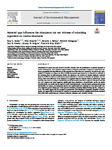Material type influences the abundance but not richness of colonising organisms on marine structures
| dc.contributor.author | Dodds, KC | |
| dc.contributor.author | Schaefer, N | |
| dc.contributor.author | Bishop, MJ | |
| dc.contributor.author | Nakagawa, S | |
| dc.contributor.author | Brooks, PR | |
| dc.contributor.author | Knights, Antony | |
| dc.contributor.author | Strain, EMA | |
| dc.date.accessioned | 2022-02-08T13:43:43Z | |
| dc.date.available | 2022-02-08T13:43:43Z | |
| dc.date.issued | 2022-04-01 | |
| dc.identifier.issn | 0301-4797 | |
| dc.identifier.issn | 1095-8630 | |
| dc.identifier.other | 114549 | |
| dc.identifier.uri | http://hdl.handle.net/10026.1/18701 | |
| dc.description.abstract |
Urbanisation of coastal areas and growth in the blue economy drive the proliferation of artificial structures in marine environments. These structures support distinct ecological communities compared to natural hard substrates, potentially reflecting differences in the materials from which they are constructed. We undertook a meta-analysis of 46 studies to compare the effects of different material types (natural or eco-friendly vs. artificial) on the colonising biota on built structures. Neither the abundance nor richness of colonists displayed consistent patterns of difference between artificial and natural substrates or between eco-friendly and standard concrete. Instead, there were differences in the abundance of organisms (but not richness) between artificial and natural materials, that varied according to material type and by functional group. When compared to biogenic materials and rock, polymer and metal supported significantly lower abundances of total benthic species (in studies assessing sessile and mobile species together), sessile invertebrates and corals (in studies assessing these groups individually). In contrast, non-indigenous species were significantly more abundant on wood than metal. Concrete supported greater abundances of the general community, including habitat-forming species, compared to wood. Our results suggest that the ecological requirements of the biological community, alongside economic, logistic and engineering factors should be considered in material selection for multifunctional marine structures that deliver both engineering and ecological (enhanced abundance and diversity) benefits. | |
| dc.format.extent | 114549-114549 | |
| dc.format.medium | Print-Electronic | |
| dc.language | en | |
| dc.language.iso | en | |
| dc.publisher | Elsevier BV | |
| dc.subject | Artificial structures | |
| dc.subject | Colonisation | |
| dc.subject | Eco-engineering | |
| dc.subject | Marine construction | |
| dc.subject | Meta-analysis | |
| dc.subject | Multifunctional design | |
| dc.title | Material type influences the abundance but not richness of colonising organisms on marine structures | |
| dc.type | journal-article | |
| dc.type | Journal Article | |
| dc.type | Meta-Analysis | |
| plymouth.author-url | https://www.webofscience.com/api/gateway?GWVersion=2&SrcApp=PARTNER_APP&SrcAuth=LinksAMR&KeyUT=WOS:000784496500004&DestLinkType=FullRecord&DestApp=ALL_WOS&UsrCustomerID=11bb513d99f797142bcfeffcc58ea008 | |
| plymouth.volume | 307 | |
| plymouth.publication-status | Published | |
| plymouth.journal | Journal of Environmental Management | |
| dc.identifier.doi | 10.1016/j.jenvman.2022.114549 | |
| plymouth.organisational-group | /Plymouth | |
| plymouth.organisational-group | /Plymouth/Faculty of Science and Engineering | |
| plymouth.organisational-group | /Plymouth/Faculty of Science and Engineering/School of Biological and Marine Sciences | |
| plymouth.organisational-group | /Plymouth/REF 2021 Researchers by UoA | |
| plymouth.organisational-group | /Plymouth/REF 2021 Researchers by UoA/UoA07 Earth Systems and Environmental Sciences | |
| plymouth.organisational-group | /Plymouth/Users by role | |
| plymouth.organisational-group | /Plymouth/Users by role/Academics | |
| plymouth.organisational-group | /Plymouth/Users by role/Researchers in ResearchFish submission | |
| dc.publisher.place | England | |
| dcterms.dateAccepted | 2022-01-15 | |
| dc.rights.embargodate | 2022-2-11 | |
| dc.identifier.eissn | 1095-8630 | |
| dc.rights.embargoperiod | Not known | |
| rioxxterms.versionofrecord | 10.1016/j.jenvman.2022.114549 | |
| rioxxterms.licenseref.uri | http://www.rioxx.net/licenses/all-rights-reserved | |
| rioxxterms.licenseref.startdate | 2022-04-01 | |
| rioxxterms.type | Journal Article/Review | |
| plymouth.funder | Decommissioning – Relative effects of alternative management strategies::UKRI; NERC |


